Pharmacogenic Myopathy: Symptoms, Causes, Treatment
What are the symptoms of pharmacogenic myopathy?
Pharmacogenetic myopathy is a rare genetic condition characterized by muscle pain, weakness, and damage caused by certain medications. The symptoms of pharmacogenetic myopathy can vary in severity and may include:
- Muscle pain: Individuals with pharmacogenetic myopathy may experience muscle pain or tenderness, especially in the shoulders, upper arms, thighs, or lower back. The pain may be persistent or worsen with physical activity.
- Muscle weakness: Weakness in the muscles, particularly in the proximal muscles (muscles closest to the trunk of the body), is a common symptom of pharmacogenetic myopathy. This weakness can impact daily activities such as climbing stairs, standing up from a sitting position, or lifting objects.
- Muscle stiffness or cramping: Some individuals with pharmacogenetic myopathy may experience muscle stiffness, cramping, or spasms, which can contribute to discomfort and limited range of motion.
- Fatigue: Muscle weakness and pain can lead to fatigue and decreased endurance in individuals with pharmacogenetic myopathy. Fatigue may persist even with adequate rest and sleep.
- Elevated creatine kinase (CK) levels: Pharmacogenetic myopathy can cause damage to muscle fibers, resulting in the release of creatine kinase (CK) into the bloodstream. Elevated CK levels in blood tests are a common finding in individuals with myopathy.
- Difficulty with coordination and balance: Muscle weakness and pain can affect coordination and balance, leading to difficulties with walking, running, or performing fine motor tasks.
- Respiratory muscle weakness: In some cases, pharmacogenetic myopathy can affect the muscles involved in breathing, leading to respiratory difficulties and shortness of breath.
It is important to note that the symptoms of pharmacogenetic myopathy can be similar to those of other muscle disorders and conditions, making the diagnosis challenging. If you experience persistent muscle pain, weakness, or other symptoms suggestive of myopathy, it is essential to seek evaluation and diagnosis by a healthcare provider. A comprehensive medical history, physical examination, laboratory tests, and genetic testing may be necessary to confirm a diagnosis of pharmacogenetic myopathy and determine the underlying cause. Treatment for pharmacogenetic myopathy may involve discontinuation of the offending medication, supportive care, physical therapy, and management of symptoms to improve muscle function and quality of life.
What are the causes of pharmacogenic myopathy?
Pharmacogenic myopathy, also known as drug-induced myopathy, can be caused by various medications. Some common causes include:
- Statins: These drugs, used to lower cholesterol, are a well-known cause of myopathy. They can lead to muscle pain, weakness, and in severe cases, rhabdomyolysis.
- Fibrates: Another class of medications used to lower cholesterol, fibrates can also cause myopathy.
- Steroids: Long-term use of corticosteroids can lead to muscle weakness and myopathy.
- Antiretroviral drugs: Some medications used to treat HIV/AIDS, particularly nucleoside reverse transcriptase inhibitors (NRTIs), can cause myopathy.
- Colchicine: Used to treat gout, colchicine can cause myopathy, especially at higher doses.
- Antimalarial drugs: Some antimalarial medications, such as chloroquine and hydroxychloroquine, can cause myopathy.
- Other medications: Certain other drugs, including some antibiotics, antipsychotics, and anticonvulsants, have been associated with myopathy.
It’s important to note that the risk of pharmacogenic myopathy varies among individuals and depends on factors such as the specific medication, dose, duration of use, and individual susceptibility. If you suspect you have pharmacogenic myopathy, it’s important to consult with a healthcare professional for proper evaluation and management.
What is the treatment for pharmacogenic myopathy?
The treatment for pharmacogenic myopathy, or drug-induced myopathy, depends on several factors, including the underlying cause, the severity of symptoms, and the specific medication involved. In general, treatment may include:
- Discontinuation or dose reduction of the offending medication: If a medication is suspected of causing myopathy, the healthcare provider may consider stopping the medication or reducing the dose if possible.
- Monitoring and management of symptoms: This may include managing pain and discomfort associated with myopathy. Physical therapy or rehabilitation may also be beneficial in some cases to help improve muscle strength and function.
- Switching to an alternative medication: In some cases, it may be possible to switch to a different medication that is less likely to cause myopathy.
- Monitoring for complications: Some cases of myopathy, particularly those associated with statins, may progress to a more severe condition called rhabdomyolysis, which can lead to kidney damage. Close monitoring for signs of rhabdomyolysis is important.
- Addressing underlying conditions: If myopathy is related to an underlying condition, such as an autoimmune disorder, addressing the underlying condition may help improve symptoms.
It’s important for individuals with pharmacogenic myopathy to work closely with their healthcare providers to develop an appropriate treatment plan. In some cases, the condition may improve once the offending medication is stopped or changed, but recovery time can vary.




